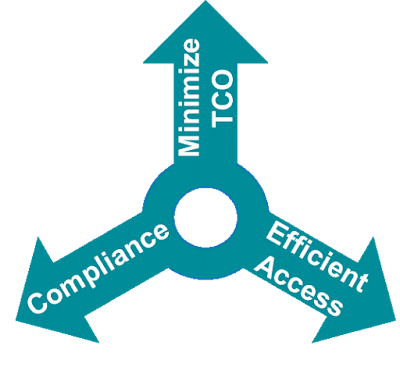When it comes to considering the move to S/4HANA, many companies are concerned by the short-term pain points that accompany the transition – even though the future benefits are so clear. While SAP provides many tools and support to make the transition as seamless as possible, many companies prefer to delay the transition and wait and see what the future holds. But “wait and see” is not a very viable business strategy.
Organizations must look for ways to simplify the move to S/4HANA and increase the ROI. The same strategies are applicable when migrating BW and/or Business Suite systems from any legacy database to SAP HANA.
Organizations must look for ways to simplify the move to S/4HANA and increase the ROI. The same strategies are applicable when migrating BW and/or Business Suite systems from any legacy database to SAP HANA.
Data management strategies can help simplify several factors:
1. Reduce the Total Cost of Ownership (TCO) for the S/4HANA based landscape using information management technology
2. Provide efficient access to historic information for business users
3. Minimize risk by enforcing compliance with internal and/or external retention requirements
Reduce Total Cost of Ownership
The TCO of S/4HANA is strongly correlated to the volume of data maintained in the system. While the compression and data aging available with the SAP HANA platform enables organizations to store more data than in traditional databases, data aging is only available for limited objects. Therefore, organizations must think about how to control data volume if they want to control costs.
When you move to a new SAP system, you should only move the information that will be required in the new system. Archive and purge any information that is no longer used and has reached its end of life, and archive/move information that is used less frequently into long-term (archive) storage.
Efficient Access
Much of the appeal of data aging in S/4HANA is that it provides users with efficient access to older data from within the same database. Data owners can therefore access the data they want whenever they need it and do not require special training or support. However, the cost of providing this access on SAP HANA is quite high, especially for systems with large data volumes.
If efficient access is what is required, data archiving can provide users with access to data at a fraction of the cost of what it would be on the SAP HANA platform. In the era of in-memory systems, data that is accessed infrequently, such as data that is only retained for audit requirements or that is accessed for occasional reporting queries, can be easily moved to less expensive archive storage without sacrificing ease of access for users. In addition to the savings associated with moving to a less costly database, it also enables organizations to leverage existing investments in repositories.
When data archiving is used in combination with add-on solutions such as the PBS archive modules which provide seamless access to archived data, the speed and ease of accessing archived data from an ArchiveLink certified repository is as fast as accessing data in online systems. The speed and efficiency of access to archived data has been proven by many of the largest companies running SAP systems over many years.
A multi-tiered approach to data management, that incorporates data archiving with data aging will enable companies to have efficient access to data while also aligning the true cost of storing data with the value of the data to the business.
Ensure Information Compliance
Compliance is increasingly a concern for businesses that run SAP systems. Every business, regardless of industry, is subject to fiscal, legal, and other regulations. While many understand how to comply with these regulations when it comes to paper documents, organizations are also obligated to retain the online information in SAP systems in accordance with the same regulations.
The occasion of moving to a new system such as S/4HANA provides a perfect opportunity to review existing systems. Before converting systems, ensure that the online information in the existing source system complies with applicable regulations and if it does not, plan to bring that information into compliance. Businesses should ensure that:
- Information is protected from modification and premature destruction
- Information is retained as long as necessary, but not longer
- Retention and purging of information follows a controlled process, as defined in your corporate records retention policy
Data archiving can play an important role in the process because it enables organizations to freeze data to prevent future modification. Also, data cannot be changed after it is archived which is an important proof of compliance for many fiscal and legal retention requirements.
While it is difficult to assign a hard cost to compliance, the global increase in regulations and the impact of being found non-compliant cannot be ignored. Even with data aging in S/4HANA, archiving will continue to play an important role in information compliance.

No comments:
Post a Comment